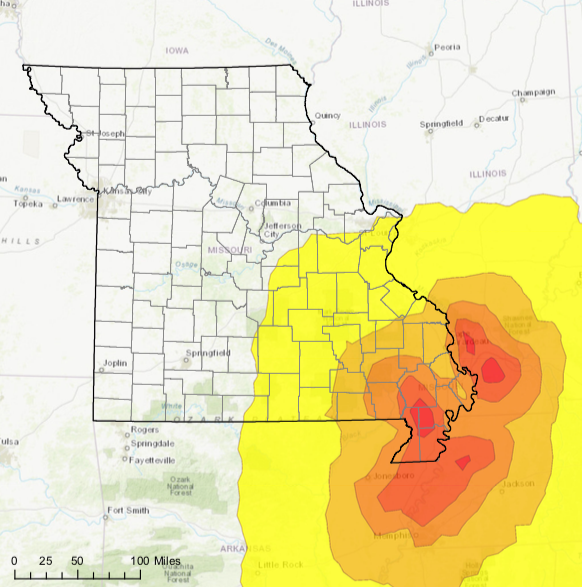Earthquake Preparedness: Here's What You Can Do
 Three of the largest earthquakes experienced in the continental United States occurred in the New Madrid Seismic Zone in 1811-12. Southeast Missouri continues to experience over 200 measurable minor earthquakes each year. Occasionally, residents can feel some of those minor earthquakes. Because a New Madrid Seismic Zone earthquake cannot be predicted, it is important to take steps to learn about earthquakes and to protect yourself.
Three of the largest earthquakes experienced in the continental United States occurred in the New Madrid Seismic Zone in 1811-12. Southeast Missouri continues to experience over 200 measurable minor earthquakes each year. Occasionally, residents can feel some of those minor earthquakes. Because a New Madrid Seismic Zone earthquake cannot be predicted, it is important to take steps to learn about earthquakes and to protect yourself.
The following preparedness tips can help you survive an earthquake:
What to do before an earthquake:
- Identify safe spots and danger zones in each room.
- Buy a large garbage can to store bottled drinking water, canned and dried non-perishable food that does not need to be cooked (tuna and crackers, for example), a can opener, flashlights, first aid supplies, battery powered radio, seasonal clothing and blankets. It may also become your “go kit” if you need to leave your home.
- Know how to shut off all utilities.
- Be sure your house is firmly anchored to its foundation.
- Anchor overhead lighting fixtures.
- Store bottled foods, glass, china and other breakable items on low shelves or in cabinets that can fasten shut. Place large or heavy objects on lower shelves.
- Brace bookshelves and heavy furniture to walls to keep them from toppling.
- Repair defective electrical wiring.
- Install flexible lines to water heaters, gas stoves and other appliances.
- Securely fasten water heaters and gas appliances to wall studs.
- Buy earthquake insurance.
What to do during an earthquake:

- If indoors – take cover under sturdy furniture or against an inside wall. “Drop, Cover and Hold On” until the shaking stops. This means DROP down to the floor, take COVER and protect your head and neck with your arms, and HOLD ON to the sturdy piece of furniture you are under until the shaking stops.
- If outdoors – stay there. Move away from buildings, streetlights and utility wires.
- In a high-rise building – take cover under sturdy furniture away from windows and outside walls. Stay in the building on the same floor. An evacuation may not be necessary. Wait for instructions from safety personnel. Do not use elevators.
- In a vehicle – stop as quickly as safety permits, and stay in the vehicle. Avoid stopping near or under buildings, trees, overpasses or utility wires.
What to do immediately after an earthquake:
- Check for injuries.
- Be prepared for aftershocks.
- Wear sturdy shoes in areas covered with fallen debris and broken glass.
- If the electricity is out – use flashlights or battery operated lanterns. Check the main utility panel.
- If you smell gas or hear a hissing sound – open a window and leave the building. Shut off the main gas valve outside the building.
- If water pipes are damaged – shut off the water supply at the main valve.
- Check your home and chimney for structural damage
- Check household appliances for damage.
- Clean up spilled medicines, bleaches, gasoline and other flammable liquids.
- Do not flush toilets until you know sewage lines are intact.
- Open cabinets cautiously because objects may fall off shelves.
- Use the phone only to report a life-threatening emergency.
- Listen to news reports for the latest emergency information.

